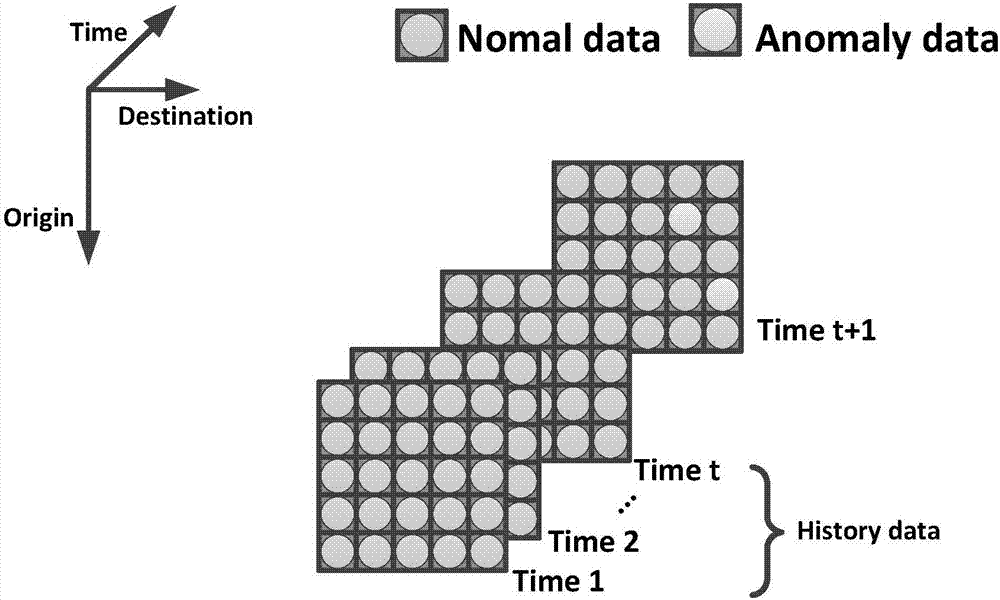Online network traffic abnormality detection method based on bidirectional two-dimension principal component analysis
A two-dimensional principal component and network traffic technology, which is applied in the field of online network traffic anomaly detection by two-dimensional principal component analysis, can solve the problems of damage, the calculation time cost cannot meet the online detection, and the internal properties and characteristics of the data are destroyed. The effect of convenient network management
- Summary
- Abstract
- Description
- Claims
- Application Information
AI Technical Summary
Problems solved by technology
Method used
Image
Examples
no. 1 example
[0067] The described BPCA algorithm of the first embodiment of the present invention is as follows:
[0068] Given a dataset where X i ∈R N×N , i=1...T, centralize these data in like Figure 1.2 The Distance shown in is expressed in BPCA as:
[0069]
[0070] Where U and V are column and row space vectors respectively, and U T , V T , is U, V transpose. It can be found
[0071] The proof is as follows:
[0072] first order but
[0073]
[0074] because is a constant, so (1) can be expressed as
[0075]
[0076] After derivation, we can get:
[0077]
[0078] if and only if: Equation (3) obtains the minimum value, so it is brought into to (2) formula.
[0079]
[0080] Also the first term is a constant, so:
[0081]
[0082] In order to optimize the objective function (6), when given a U opt , U opt The covariance matrix can be calculated by The first L eigenvectors of the singular value decomposition are obtained. Similarly, g...
no. 2 example
[0092] By observing the calculation process of the above method, it is found that this process requires repeated iterations, so the calculation cost is relatively high. Therefore, in the second embodiment, the present invention proposes a kind of approximate solution algorithm of this BPCA method, and concrete method is as follows:
[0093] By observing the third and fourth steps in the above-mentioned method steps, we can know that when performing singular value decomposition, when R and L are large enough, we can get as well as Therefore this specific embodiment proposes the BPCA method of approximation, and it comprises following specific steps:
[0094] Step 1: Calculate and pass C V The singular value decomposition of i ;
[0095] Step 2: Calculate and pass C U The singular value decomposition of , find the U i ;
[0096] Step Three: End.
no. 3 example
[0098]Proved by a large number of experiments, this approximate BPCA method still can not meet the requirement of online detection, therefore, for this approximate BPCA method, the third embodiment of the present invention proposes a kind of incremental (incremental) method, In this way, the computational cost can be greatly reduced.
[0099] The incremental method includes the following steps:
[0100] Step 1: Input the new sampled data matrix X t+1 , historical sampling data mean matrix And the eigenvectors of historical data in column space and row space and the singular value matrix
[0101] Step 2: Calculate
[0102] Step 3: Calculate the QR decomposition: where Q u , R u ,Q v , R v for the matrix Two matrices obtained by QR decomposition;
[0103] Step 4: Calculate SVD decomposition (Singular Value Decomposition):
[0104]
[0105]
[0106] in for the matrix The three matrices obtained by performing singular value decomposition;
[0107] ...
PUM
 Login to View More
Login to View More Abstract
Description
Claims
Application Information
 Login to View More
Login to View More - R&D
- Intellectual Property
- Life Sciences
- Materials
- Tech Scout
- Unparalleled Data Quality
- Higher Quality Content
- 60% Fewer Hallucinations
Browse by: Latest US Patents, China's latest patents, Technical Efficacy Thesaurus, Application Domain, Technology Topic, Popular Technical Reports.
© 2025 PatSnap. All rights reserved.Legal|Privacy policy|Modern Slavery Act Transparency Statement|Sitemap|About US| Contact US: help@patsnap.com



